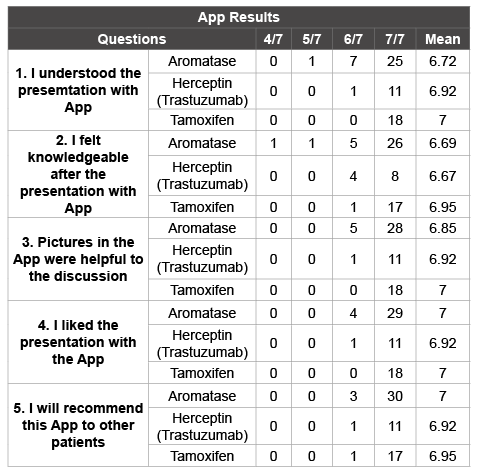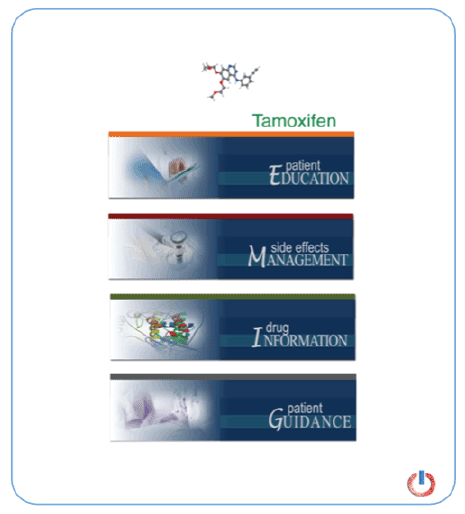
Figure 1: Icons for Individual Apps – Tamoxifen-for Temoxifen therapy; Aromatase-for Anastrozole, Letrozole or Exemestane therapy; Her2- Neu-for Herceptin therapy

Younus J* Kligman L
Division of Medical Oncology, London Regional Cancer Program, London, Ontario, Canada*Corresponding author: J Younus, Division of Medical Oncology, London Regional Cancer Program (LRCP), 790 Commissioners Road E. London, Ontario N6A 4L6, Canada, Tel: 519-685- 8640; Fax: 519-685-8624; E-mail: Jawaid.Younus@lhsc.on.ca
Article Type: Research Article
Citation: Younus J, Kligman L (2016) Mobile Devices Applications for Patient Education. Int J Cancer Res Mol Mech 2(2): doi http://dx.doi.org/10.16966/2381- 3318.128
Copyright: © 2016 Younus J, et al. This is an open-access article distributed under the terms of the Creative Commons Attribution License, which permits unrestricted use, distribution, and reproduction in any medium, provided the original author and source are credited.
Publication history:
Background: Explaining targeted therapies to oncology patients is a challenging task for most health care professionals (HCPs). We opted to explore a unique pictorial approach with Apps for patient education.
Design/Methods: Three applications (Apps), one each for Tamoxifen, Aromatase inhibitors (AI’s) and Trastuzumab were created, utilizing the iPhone/iPad platform. The content of these Apps was approved through Breast Disease Site Team and Patient Education Committee. The study was approved by the Ethics Committee at the Western University. After obtaining consent, the Apps with animated cartoons were verbally reviewed with adult patients with breast cancer by the HCP. A patient satisfaction survey and two “exam” questions with a multiple-choice answer format were completed after each App was used by a HCP.
Results: A total of 64 patients participated, 33 with the AI App, 19 with the tamoxifen App and 12 with the trastuzumab App. For the “exam questions” segment, there were no wrong answers given. The vast majority of patients rated the Apps very highly on all questions with the mean for these questions ranging between 6.67 to 7 on the visual analogue scale.
Conclusions: The use of Apps is a novel and effective approach to educate oncology patients regarding molecularly targeted treatments. These Apps are quick, easy to use, with smart phones or an I-pad. From our results, it appears that patients liked this approach and actually understood the contents explained to them.
Tamoxifen; Aromatase inhibitors; Trastuzumab; Apps
It is a challenging task to explain complex treatments to patients with oncological diagnoses. Such therapies may include molecularly targeted small molecules, biologics and various supportive care medicines. Many health care professionals in Ontario rely on medical information sheets from different resources, such as Cancer Care Ontario, to provide basic information to their patients about these therapies. However, it is estimated that a large proportion of patients may not be able to understand the usual written material provided [1].
The pictures instead of a text are known to enhance the understanding of patients [2,3]. Patients at all educational levels may have a better understanding of complex medical concepts, including the rationale for use in the treatment of their particular cancer, by supplementing the text handouts with verbal explanations and cartoon pictures [4-8].
Information about these targeted type therapies needs to be given to patients in an easily understandable format. Applications (“apps”) on smart phones are now increasingly used by health care professionals to enhance their efficiency in delivering patient care [9]. Using “apps” to teach patients seem a logical next step.
A team consisting of a nurse practitioner, a medical oncologist and an information technology engineer developed a series of pictures for three mobile apps: Tamoxifen, Aromatase inhibitors and Trastuzumab (Figure 1). The project was partially funded by Medical Oncology Research Fund (MORF) at the London Regional Cancer Program while technical development was sponsored by a local information technology companyi. There are many resources on web available to provide text information and some with pictures; however, there is no App available at App stores for patient education on targeted therapies.

Figure 1: Icons for Individual Apps – Tamoxifen-for Temoxifen therapy; Aromatase-for Anastrozole, Letrozole or Exemestane therapy; Her2- Neu-for Herceptin therapy
The contents of these apps were discussed at the London Regional Cancer Program (LRCP) breast cancer multi-disciplinary team rounds. The drafts, once formalized, were also approved through the patient education committee at LRCP. This series of pictures/cartoons under each app were presented at three different cancer centers in Ontario. The health care professionals at these centers were requested to use these apps with their patients and provide feedback to the designing team (Figure 2). After incorporating the feedback, the final three apps were downloaded on the iphone 4 and 5 platforms as well as the iPod. A study proposal to test these apps from the patient’s perspective was constructed and approved by the ethics committee at Western University, London, Ontario. All adult patients with breast cancer undergoing adjuvant treatment with Tamoxifen, Aromatase inhibitors and/or Trastuzumab were considered eligible. The study was described to potential participants and written consent was obtained. The respective app was shown to the patients and verbally explained at the same time. A patient questionnaire was developed as a simple evaluation tool to gauge patients’ response to the use of Apps. The questionnaire specifically centered areas like understanding, knowledge, app’s value as an aid to discussion etc.. At the end of the presentation, patients were requested to fill out the patient satisfaction questionnaire with five questions. Patients were instructed to use a simple visual analogue scale and circle the number between 1 and 7 to answer these questions. A score of one reflected their complete disagreement and 7 showed their complete agreement. In order to assess the immediate understanding after the presentation with app, two examination questions with four possible choices as answers were developed. These questions were specific to each targeted therapy, Tamoxifen, Aromatase inhibitors and Trastuzumab (Herceptin). These patients were asked to answer two examination questions with 4 possible choices for each as answers. The first question evaluated their understanding of the mechanism of action of the described therapy while the second question explored the possible side effect of the treatment.

Figure 2: Sample screen capture from Aromatase inhibitor App, showing the pictorial concept of pre and post menopause status and correlating level of estrogen
A total of 64 patients were screened and consented and there was no refusal to participate. The Aromatase inhibitor app was used with 33 patients while Tamoxifen and Trastuzumab apps were described to 19 and 12 patients respectively. All patients answered both examination questions correctly. The survey questions were designed to gain insight about the apps and their contents from the patients’ perspective (Table 1). There were two patients who rated being knowledgeable after aromatase inhibitor app presentation as 4/7 and 5/7, while one patient rated the understanding score with the same app as 5/7. The majority of patients rated all domains for all three apps highly, 6/7 (34 answers) or 7/7 (278 answers).

Table 1: The survey questions to gain insight about the apps and their contents from the patients’ perspective
The task of explaining complex molecularly targeted therapies to cancer patients is not only challenging and time consuming for HCPs but also difficult for patients to understand (Figure 3). The written information sheets about these drugs provided routinely to patients lack certain basic pieces of information like mechanism of action and benefits. This information must be presented to these patients in an easy to understand format. In order to accomplish these steps, we constructed cartoon depictions of all such related information under three apps utilizing iphone platform (4 through 5 and now upgraded to version 6 and iPad). We elected to use the iPhone as this brand is one of the most commonly used smart phones and tablets worldwide. In addition, Apple’s closed operating system mandates all apps to be developed under certain preapproved rules and regulations, ensuring high quality software.

Figure 3: Pictoral explanation of Trastuzumab therapy to cancer
Counseling cancer patients is a necessity and should be done combining both art and science. It is often time constraints felt by health care providers in day to day clinical activities that restrict explanations to patients. Just handling out medical information sheets to patients likely will not fill this gap. Individual review of information material by patients may result in misunderstanding, or may never occur. The addition of a pictorial component along with a verbal explanation, as used with our App application, was well received and allowed patients as well as accompanying family members to ask questions. The use of these three Apps was timed by the HCPs to take between 3-5 minutes to explain all the contents, including the side effects.
The patient questionnaire provided us the patients’ perspective and general uptake within patient community for such apps (Figure 4). The majority of patients rated these apps high on a variety of domains like understanding, knowledge, discussion and appearance of the content for each therapy. These patients also agreed that they will recommend these apps to other patients. In fact, several of these patients expressed their wish to download these apps on their phones at the end of the study. The component with the two examination questions was specifically designed to address two issues; understanding and recall of the information. As all patients answered these questions correctly, we feel that these apps are able to convey the related information effectively.

Figure 4: App with features
We have subsequently explored the flexibility of such an app in a variety of ways. Since this study, we have added common side effects of these treatments and their suggested management. We have also added the chemical and pharmaceutical information as a ready resource for pharmacists and included a drug brochure as an education source for nurses.
This study had a few limitations. We did not record the age or the education level of individual patients. However, the age ranged between 43 to 80 years. All the participants were suggested these targeted therapies under adjuvant case-scenario and therefore the staging have ranged between stages I and III. We had simplified the verbal component, text within the app, and the evaluation questionnaires to the level of grade 5 education, as evaluated through the LRCP education committee.
These apps provide a novel and effective way to facilitate discussion between health care providers and patients about the complex subject of molecularly targeted therapies. These apps are user friendly, readily available on iPad or iphone platforms to provide pertinent information to patients. The patients liked the pictorial approach with verbal explanation and demonstrated that they understood the subject with good immediate recall.
Download Provisional pdf here
All Sci Forschen Journals are Open Access